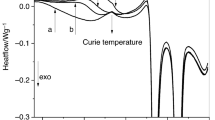Abstract
Recent work on Cu2−x Se has caused strong interest in this material due to its high reported peak zT (1.5) and the reduction of thermal conductivity through the mechanism of liquid-like suppression of heat capacity. In the 1960s, 3M patented Cu1.97Ag0.03Se as “TPM-217.” Over the following decade it was tested and developed by the 3M Corporation, at the National Aeronautics and Space Administration (NASA) Jet Propulsion Laboratory, Teledyne Energy Systems, and the General Atomics Corporation for use as a next-generation thermoelectric material. During these tests, extreme problems with material loss through Se vaporization and chemical reactions between the material and the device contacts were found. These problems were especially severe while operating under conditions of high \( iL/A. \) As a result, the material system was abandoned. The results of these reports are discussed. A simple test of degradation of Cu2Se under conditions of applied current and thermal gradient was performed and showed results compatible with the work done by General Atomics.
Similar content being viewed by others
References
M. Horvatic and Z. Vucic, Solid State Ionics 61, 117 (1984).
V.A. Chatov, T.P. Iorga, and P.N. Inglizyan, Sov. Phys. Semicond. 14, 474 (1980).
J.B. Boyce and B.A. Huberman, Phys. Rep. 51, 189 (1979).
K. Trachenko, Phys. Rev. B 78, 104201 (2008).
H. Liu, X. Shi, F. Xu, L. Zhang, W. Zhang, L. Chen, Q. Li, C. Uher, T. Day, and G.J. Snyder, Nat. Mater. 11, 422 (2012).
E.F.J. Hampl, Thermoelectric materials evaluation program. Quarterly technical task report No. 39 (Report No. MMM–2473-3421972) (DOE, 1972) doi: 10.2172/4562245.
E.F.J. Hampl, Thermoelectric materials evaluation program. Quarterly technical task report No. 46. [Minnesota Mining and Manufacturing Company, Technical Ceramic Products Div., St. Paul, 10/1 to 12/31/1975], (Report No. MMM-2473-0422) (DOE, 1976) doi: 10.2172/5311720.
E.F.J. Hampl, J.D. Hinderman, W.C. Mitchell, R.S. Reylek, and D.A. Wald, IEEE Trans. Aerosp. Electron. Syst. 11, 952 (1975).
J.D. Hinderman, Thermoelectric Materials Evaluation Program. Annual technical report for fiscal year 1979 (Report No. MMM-2331-0642) (DOE, 1979) doi: 10.2172/5741759.
J.D. Hinderman, Thermoelectric materials evaluation program. Technical summary report. (Report No. MMM-2331-0602) (DOE, 1979) doi: 10.2172/5434752.
3M Corporation. Program to design an advanced technology thermoelectric module for a 2 KW power system and to fabricate and test a heat pipe/thermoelectric module (Report No. TID/SNM—27) (DOE, 1970) doi: 10.2172/4209954.
J.D. Hinderman, SIG Galileo final converter. Technical summary report. (Report No. DOE/ET/33008-1) (DOE 1979).
N.B. Elsner, J. Chin and H.G. Staley, Radioisotope space power generator annual report, July 1, 1974–June 30, 1975. [TPM-217 P-type material and SiGe technology] (Report No. GA-A-140161976) (DOE, 1975) doi: 10.2172/4178631.
N.B. Elsner, J. Chin, H.G. Staley, J.C. Bass, E.J. Steeger, P.K. Gantzel and J.M. Neill, Radioisotope space power generator annual report for the period October 1, 1976-September 30, 1978, (Report No. GA-A-15683) (DOE, 1980) doi: 10.2172/6891182.
N.B. Elsner, J. Chin, G.H. Reynolds, J.H. Norman, J.C. Bass, H.G. Staley, Isotec Final Report (Report No. GA-A-16584) (DOE, 1981) doi: 10.2172/5437033.
N.B. Elsner and J. Chin, Radioisotope space power generator. Annual report for the period July 1, 1973–June 30, 1974 (Report no. GA-A—13426) (DOE, 1975) doi: 10.2172/4178631
G. Stapfer and L. Garvey, Progress report No. 29 for a program of thermoelectric generator testing and RTG degradation mechanisms evaluation (Report no. DOE/ET/33003-T2) (DOE, 1979) doi: 10.2172/6210722.
G. Stapfer and V.C. Truscello, Development of the data base for a degradation model of a selenide RTG (Report no. 19770066000) (NASA JPL, 1977).
G. Stapfer, Copper-selenide system, P-Type TPM-217 (Report no. DOE/ET/33003-T5) (DOE, 1977).
A. Lockwood and G. Stapfer, Thermoelectric generator testing and RTG degradation mechanisms evaluation. Progress report No. 33 (Report no. SAN-0959-T2) (DOE, 1979) doi: 10.2172/5531078.
Teledyne Energy Systems, Selenide isotope generator for the Galileo Mission. Program final report (Report no. TES-33009-46) (DOE, 1979) doi: 10.2172/5928964.
Z. Vučić, O. Milat, V. Horvatić, and Z. Ogorelec, Phys. Rev. B 24, 5398 (1981).
Author information
Authors and Affiliations
Corresponding author
Rights and permissions
About this article
Cite this article
Brown, D.R., Day, T., Caillat, T. et al. Chemical Stability of (Ag,Cu)2Se: a Historical Overview. J. Electron. Mater. 42, 2014–2019 (2013). https://doi.org/10.1007/s11664-013-2506-2
Received:
Accepted:
Published:
Issue Date:
DOI: https://doi.org/10.1007/s11664-013-2506-2




